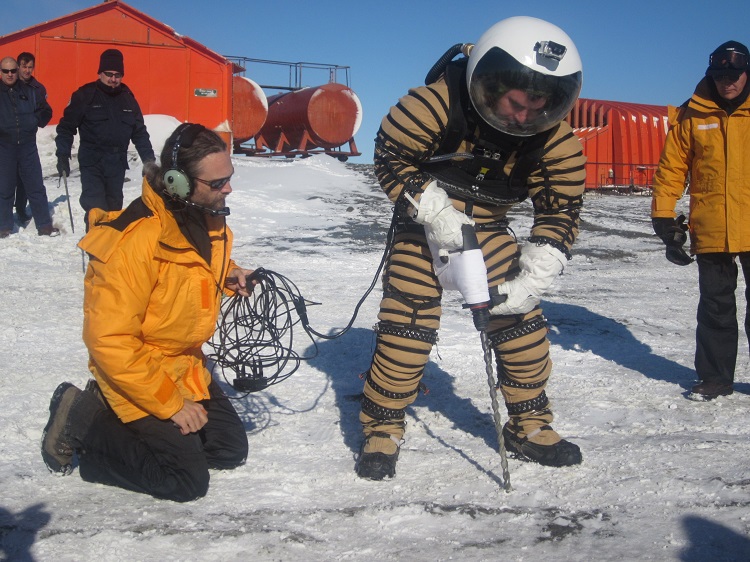Fabric from UND-developed spacesuit to spend year in space

Pieces of fabric from the University of North Dakota-developed NDX-1 spacesuit was launched into space aboard a Northrup Grumman “NG CRS-11 Cygnus” Resupply Mission, on Wednesday, on its way to the International Space Station (ISS).
The launch took place at the Wallops Flight Facility in Greenbelt, Md. Wallops is operated by the NASA Goddard Space Flight Center.
NASA selected five technologies to test as part of its Materials International Space Station Experiment (MISSE)-11 mission, including the NDX-1 spacesuit sample provided by the UND Space Studies Department.
The MISSE program provides long-term exposure of materials to the inhospitable environments of space environment, according to Pablo de León, a space studies professor at UND and primary inventor of the NDX-1 suit. All the materials are slated to remain in space for at least one year, allowing researchers to assess long-term impact of temperature extremes and radiation on their performance.
MISSE has been a successful part of ISS research since 2001, when its original flight hardware became the first payload to be installed on the outside of the space station.
Private partnership
The NDX-1 spacesuit sample will be part of an “Electrodynamic Dust Shield” experiment, with Carlos Calle, from NASA’s Kennedy Space Center in Florida, as principal investigator. The NDX-1 fabric sample aboard the ISS includes an innovative dust-mitigation technology, developed by de León and Kavya Manyapu, a UND alumna and adjunct professor in the Space Studies Department. Manyapu defended her doctoral thesis in 2017, becoming UND Space Studies’ first-ever PH.D. graduate.
Manyapu is an aerospace test engineer, who played a part in designing a commercial spacecraft for Boeing Company, and has been a member of the Mars Society research project that prepares humans for life on Mars someday.
“It’s really exciting to see samples based on my Ph.D. research launching to Space station as part of the MISSE platform,” Manyapu said. “The payload will provide critical data for furthering a novel technology to make sustainable human spaceflight exploration on the moon and Mars a reality. The technology will help to keep astronauts and space habitats safe from dust contamination. I look forward to continuing our research at UND and Dr. de León’s efforts to put humans back on the moon, and eventually, the first human footsteps on Mars”
The fabric sample uses a new private-industry screen-printing technology that was developed specifically for the space mission.
“Due to the short time we had to test and fly this payload, we reached out to private industry and found Austin, Texas-based NovaCentrix Corp., which manufactures high-quality conductive inks and printed electronics,” de León said. “They were able to help us to print the screen we needed into the spacesuit fabric and deliver it in time to the Kennedy Space Center.”
Rudy Ghosh, an academic liaison with NovaCentrix, offered to test several conductive paints on the fabric and one of them was selected for the spaceflight.
“Since it will be exposed to space for one year, we needed to be sure it will not delaminate, so upon return, we can test it and see if the dust-repealing capabilities stay the same,” de León said. “This technology will be vital during lunar and Mars exploration.”
Fabric from UND-developed spacesuit to spend year in space
Pieces of NDX-1 launched Wednesday aboard Northrup Grumman rocket headed to International Space Station
Pieces of fabric from the University of North Dakota-developed NDX-1 spacesuit was launched into space aboard a Northrup Grumman “NG CRS-11 Cygnus” Resupply Mission, on Wednesday, on its way to the International Space Station (ISS).
The launch took place at the Wallops Flight Facility in Greenbelt, Md. Wallops is operated by the NASA Goddard Space Flight Center.
NASA selected five technologies to test as part of its Materials International Space Station Experiment (MISSE)-11 mission, including the NDX-1 spacesuit sample provided by the UND Space Studies Department.
The MISSE program provides long-term exposure of materials to the inhospitable environments of space environment, according to Pablo de León, a space studies professor at UND and primary inventor of the NDX-1 suit. All the materials are slated to remain in space for at least one year, allowing researchers to assess long-term impact of temperature extremes and radiation on their performance.
MISSE has been a successful part of ISS research since 2001, when its original flight hardware became the first payload to be installed on the outside of the space station.
Private partnership
The NDX-1 spacesuit sample will be part of an “Electrodynamic Dust Shield” experiment, with Carlos Calle, from NASA’s Kennedy Space Center in Florida, as principal investigator. The NDX-1 fabric sample aboard the ISS includes an innovative dust-mitigation technology, developed by de León and Kavya Manyapu, a UND alumna and adjunct professor in the Space Studies Department. Manyapu defended her doctoral thesis in 2017, becoming UND Space Studies’ first-ever PH.D. graduate.
Manyapu is an aerospace test engineer, who played a part in designing a commercial spacecraft for Boeing Company, and has been a member of the Mars Society research project that prepares humans for life on Mars someday.
“It’s really exciting to see samples based on my Ph.D. research launching to Space station as part of the MISSE platform,” Manyapu said. “The payload will provide critical data for furthering a novel technology to make sustainable human spaceflight exploration on the moon and Mars a reality. The technology will help to keep astronauts and space habitats safe from dust contamination. I look forward to continuing our research at UND and Dr. de León’s efforts to put humans back on the moon, and eventually, the first human footsteps on Mars”
The fabric sample uses a new private-industry screen-printing technology that was developed specifically for the space mission.
“Due to the short time we had to test and fly this payload, we reached out to private industry and found Austin, Texas-based NovaCentrix Corp., which manufactures high-quality conductive inks and printed electronics,” de León said. “They were able to help us to print the screen we needed into the spacesuit fabric and deliver it in time to the Kennedy Space Center.”
Rudy Ghosh, an academic liaison with NovaCentrix, offered to test several conductive paints on the fabric and one of them was selected for the spaceflight.
“Since it will be exposed to space for one year, we needed to be sure it will not delaminate, so upon return, we can test it and see if the dust-repealing capabilities stay the same,” de León said. “This technology will be vital during lunar and Mars exploration.”


